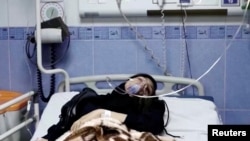Dozens of schools in several provinces of Iran have been targeted by gas and chemical attacks that began in November, but now two officials in President Ebrahim Raisi's government are asserting the spate of school poisonings was "the mischief of the students."
"The few cases of poisoning that occurred in [the] girls' schools were very limited. The mischief of some students was to close the classes," Seyyed Majid Mirahmadi, deputy minister of the Interior Ministry, said Saturday.
"In the statements of the Ministry of Interior regarding the recent events in some schools, everything has been explained, and with the beginning of the school year, all the schools are active, and all the students are studying," he added.
However, VOA's Persian service observed credible reports of incidents in 14 cities on April 14. Those reports, which VOA cannot independently verify because it is barred from reporting in Iran, came from the cities of Amol, Borujerd, Ganaveh, Isfahan, Kamyaran, Karaj, Kermanshah, Mashhad, Oshnavieh, Shahin Shahr, Tabriz, Tehran, Urmia and Zanjan.
In mid-March, Iran state media said more than 1,200 Iranian girls from at least 60 schools had become ill since last November in what may have been chemical or biological attacks. Human Rights activists in Iran had put the number at more than 7,000 students.
On March 7, Mirahmadi said on state television that "a number of people have been arrested in five provinces," according to The Guardian newspaper, though he did not provide details on those detained. On March 15, Iranian police reported the arrests of 110 suspects.
Another senior member of the government, Health Minister Bahram Einollahi, insisted there was no "solid evidence" to show that students were poisoned.
According to Iran's Tasnim news agency, Einollahi called the poisoning of female students in Iran "disgusting" but went on to say that in more than 90 of the cases documented "no type of poisoning can be seen."
Einollahi emphasized, "A scientific committee consisting of the best professors in the country has investigated the issue and announced that the victims of serial poisonings were more stressed and some of them were related to 'mischief.'"
The scientific committee of the Health Ministry confirmed in an earlier report that some of the students were poisoned with a stimulant substance that is "mainly inhaled."
Saeed Karimi, deputy medical director of the Health Ministry, said in March: "This case has several parts; some of the students were exposed to an irritating substance that is mainly inhaled. This section is part of the collection of children who were sent to the emergency room."
The parliament has also confirmed the occurrence of poisonings, and Mohammed Hassan Asefari, a key lawmaker and member of the "fact-finding committee" of the parliament, told the semiofficial ISNA news agency in March that as many as 5,000 students have complained of being sickened in 230 schools across 25 provinces.
Over the past five months, female students were poisoned at hundreds of schools. Critics contend Iranian authorities have not taken any effective measures to deal with the perpetrators of these attacks.
The Islamic Republic authorities have blamed foreign interference, a collection of nefarious people, and internal factors for the poisonings.
Some of the information for this report came from The Associated Press and Reuters.








